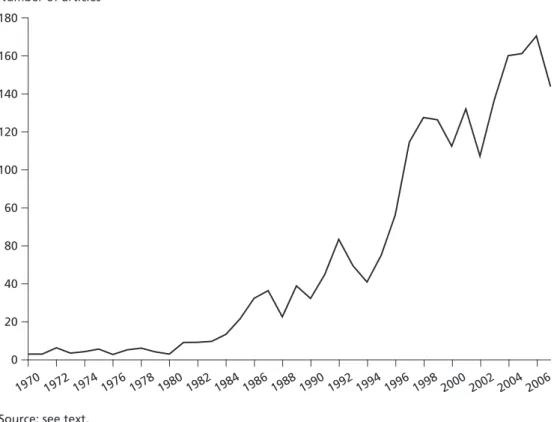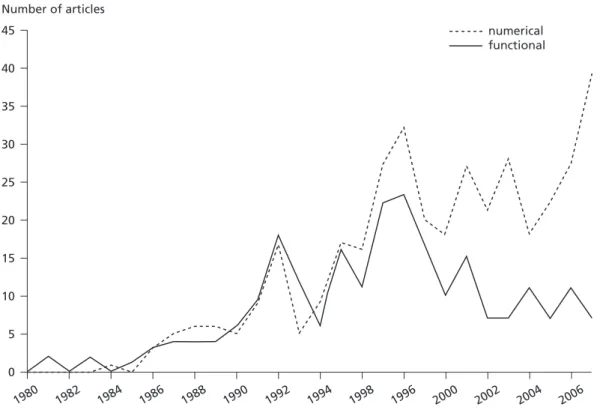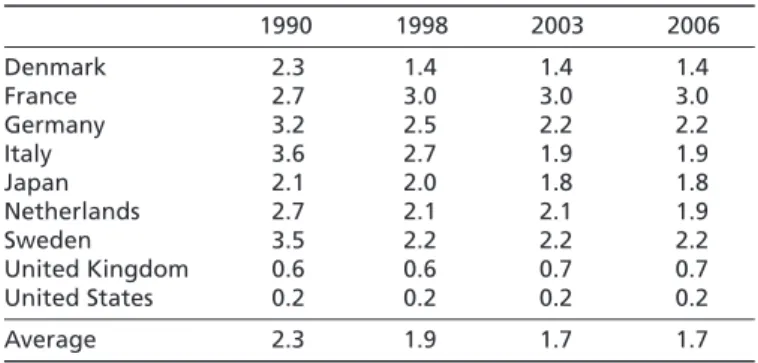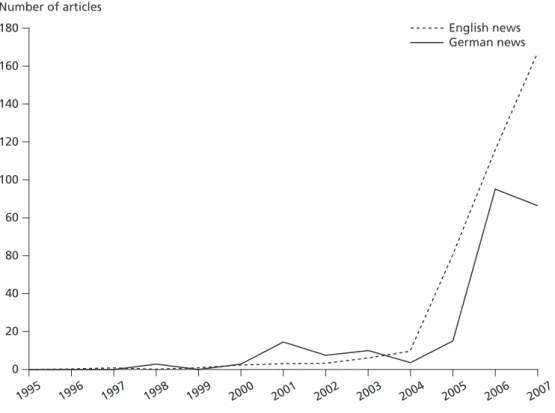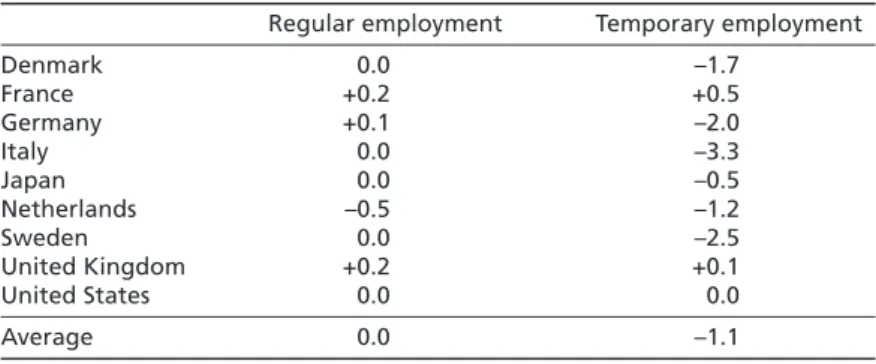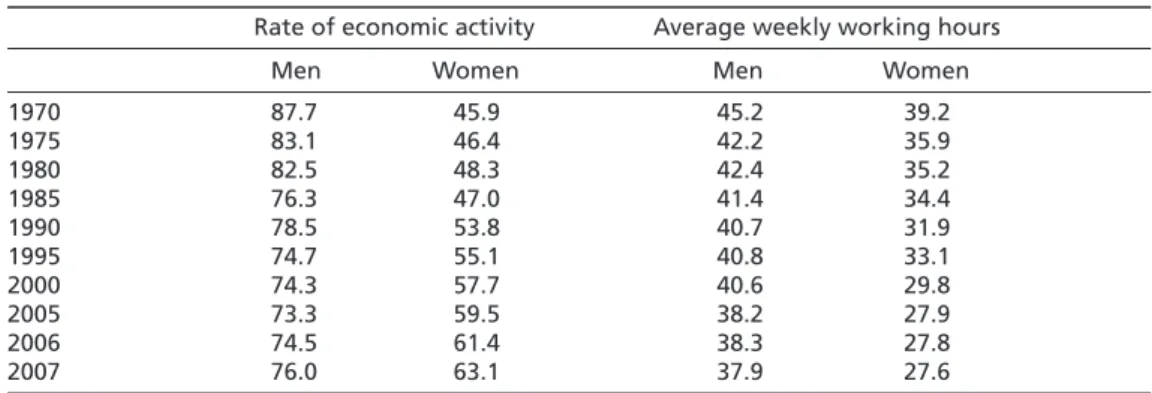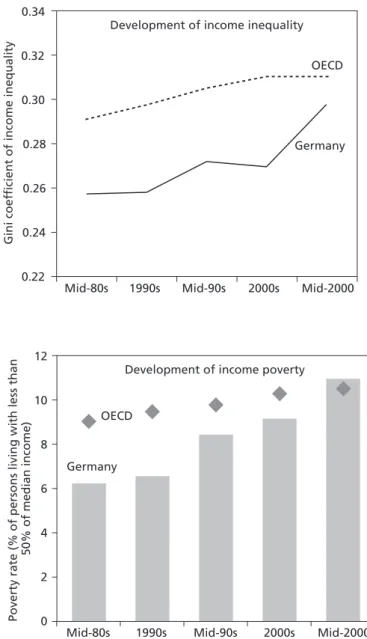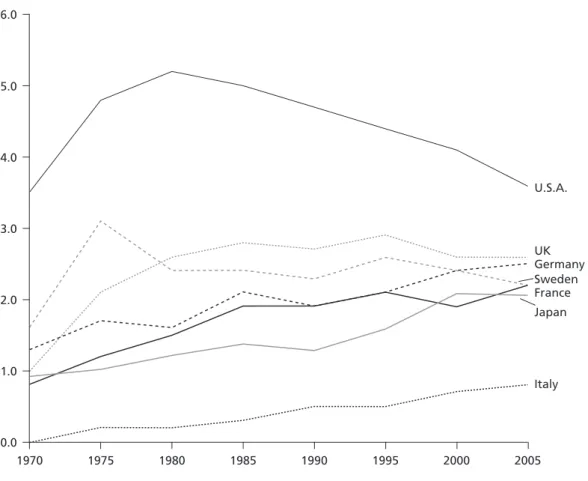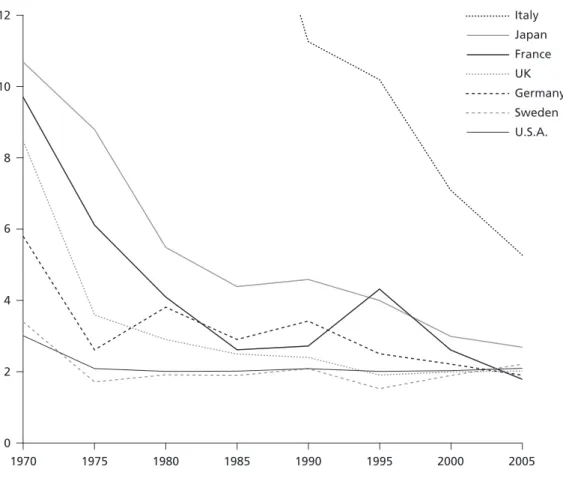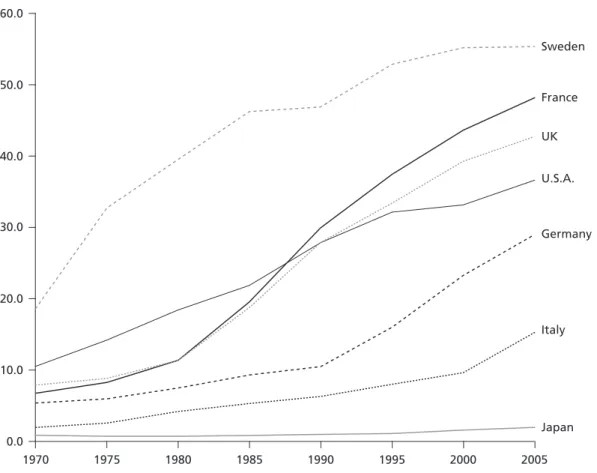MPIfG Working Paper Wolfgang Streeck
Flexible Employment, Flexible Families,
and the Socialization of Reproduction
Max Planck Institute for the Study of Societies, Cologne November 2009
MPIfG Working Paper ISSN 1864-4341 (Print) ISSN 1864-4333 (Internet)
© 2009 by the author(s)
Wolfgang Streeck is Director at the Max Planck Institute for the Study of Societies.
streeck@mpifg.de
MPIfG Working Papers present ideas that could guide future scholarly research. They may also draw out the implications of available knowledge for a better understanding of public-policy issues. MPIfG Working Papers are refereed scholarly papers.
Downloads www.mpifg.de
Go to Publications / Working Papers
Max-Planck-Institut für Gesellschaftsforschung Max Planck Institute for the Study of Societies Paulstr. 3 | 50676 Cologne | Germany
Tel. +49 221 2767-0 Fax +49 221 2767-555 www.mpifg.de info@mpifg.de
for the stability and performance of societies. As markets advance, pressures build on the state to replace informal social obligations with formal ones. Regulation may fail, however, which tends to give rise to demands for public services substituting for private reciprocity and compliance with institutionalized normative expectations. As a result, demands on public finances increase. The paper demonstrates this sequence by describing how the pressures and attractions of labor markets undermined the “Fordist family” of the 1960s; how the complex interaction between increasingly more flexible employment and loosening family structures resulted in declining fertility in a variety of modern societies; and how providing for societies’
physical reproduction increasingly became a matter of public policy in some countries but not in others. Parallels are drawn to active labor market policy and the recent rescue of the money-making industry by Western governments. Moreover, special attention is paid to dif- ferences between countries, especially Sweden on the one hand and the United States on the other, in particular to the conditions under which governments apparently can afford not to heed calls for ever deeper and ever more expensive intervention in social relations. Exploring the increasingly negative relationship between fertility and “familialism,” the paper also shows how advanced commodification of labor and individualization of social life has effectively made it impossible to return to traditional social arrangements, such as the postwar family.
Zusammenfassung
Mit der Ausbreitung von Märkten zerfallen traditionale solidarische Beziehungen, die für so- ziale Stabilität und das Funktionieren von Gesellschaften von Bedeutung sind. Damit nimmt der Druck auf den Staat zu, informelle Verpflichtungen durch formelle zu ersetzen. Staatliche Regulierung sozialen Handelns stößt jedoch auf Grenzen. Die Folge sind Forderungen an den Staat, den Ausfall privater Reziprozität und mangelnde Befolgung formalisierter Ver- haltenserwartungen durch Bereitstellung öffentlicher Dienstleistungen zu kompensieren. Als Ergebnis wachsen die Ansprüche der Gesellschaft an die staatlichen Finanzen. Das Papier verfolgt diese Sequenz am Beispiel der Auflösung des „Fordistischen“ Familienmodells der 1960er Jahre unter dem Druck sowohl der Zwänge als auch der Attraktivität zunehmend of- fener, deregulierter Arbeitsmärkte. Es zeigt, wie die komplexe Interaktion zwischen flexible- rer Beschäftigung und lockereren Familienstrukturen zu einem Rückgang der Geburtenraten in verschiedenen modernen Gesellschaften führte und wie als Folge die physische Reproduk- tion der Gesellschaft in einigen, aber nicht in allen Ländern zu einem legitimen Gegenstand öffentlicher Politik wurde. Das Papier verweist auf Parallelen mit der aktiven Arbeitsmarkt- politik und der kürzlichen Rettung der Geldindustrie durch die westlichen Regierungen. Da- bei zeigen sich erhebliche Unterschiede zwischen verschiedenen Ländern, wie den USA und Schweden, vor allem in Bezug auf das Ausmaß, in dem es den Regierungen möglich ist, Rufe nach immer tieferen und immer teureren Interventionen in soziale Verhältnisse zu ignorie- ren. Das Papier zeigt ferner anhand des zunehmend negativen Zusammenhangs zwischen Fertilität und einer „familialistischen“ Kultur und Sozialpolitik, wie die fortgeschrittene Kommodifizierung der Arbeit und die Individualisierung des sozialen Lebens eine Rückkehr zu traditionalen sozialen Arrangements, insbesondere der Familie, zunehmend ausschließt.
2 Flexible families 14
3 Market attractions, market pressures 19
4 The socialization of reproduction 22
5 The United States: Low spending, high fertility 27
6 Germany: High spending, low fertility 28
7 Winding up the family 31
8 More market, more state? 33
References 35
Different parts of this paper were presented as lectures or seminars at the London School of Eco- nomics (LSE; March 12, 2009), the Deutsches Institut für Japanstudien (DIJ; June 2, 2009), and Harvard University (July 26, 2009). I am indebted to Alexander Schüller and Daniel Mertens for indefatigable assistance with the compilation of the statistical data.
Free markets can be demanding on societies, and this in turn can be expensive for gov- ernments. The spread of markets undermines traditional social obligations and com- munal ways of life, draining important sources of social integration and stability. This is why capitalist market economies tend to generate a continuous stream of demands for social reconstruction by public policy. Relations of solidarity that become defunct with the advance of markets call for replacement with functionally equivalent public institu- tions; formal regulation must substitute for informal social control; mutual confidence needs to be restored where traditional self-restraint has eroded; and emerging new risks require containment and insurance by public authority.
Far from making the state disappear, capitalist progress continuously gives rise to new pressures for political compensation of its adverse side-effects on social life, and indeed on economic life as well. Instead of withering away, modern states seem to be experienc- ing a growing gap between a growing demand for reconstructive political intervention and the limited resources that a private economy and a free society are willing to concede to them to pay for it. In fact, a driving force behind political-economic liberalization in the past two decades seems to have been attempts of governments to defend their capac- ity to govern by returning responsibility for coping with the consequences of market expansion to societies and markets themselves. If nothing else, the current financial crisis is making states and governments face the central political question of how they can satisfy increasing demands for public intervention with the limited means they have available, and which social dysfunctions generated by an expanding capitalist market economy they can afford not to address. Which claims for reconstructive social surgery by public provision can governments fend off without causing unacceptable risks for political and social stability? What are the likely consequences of states being unable or unwilling to intervene in societies and economies in response to the socially destructive side-effects of expanding markets? And what are the conditions under which states can stand back and leave it to their societies and economies to deal with the social repercus- sions of markets and capitalism on their own?
Exploring the relationship between expanding markets, changing social structures and political intervention, the present paper looks at the way in which the physical repro- duction of society has or has not become a subject of public policy in the course of the accelerated commodification of labor in the past two decades and the simultaneous transformation of the postwar family. It begins by recounting the advance of labor mar- ket flexibility after the 1970s; the political attempts to make that advance compatible with individual security and social stability; and the laissez-faire default option, which is acceptance of social and economic dualism. Next, it asks why the destruction of the
postwar standard employment relationship met with so little resistance, suggesting that one reason was that the rise of flexible employment was intertwined in various ways with a transition to more flexible families. The paper discusses how the two develop- ments – intensified commodification of labor, in particular the increased labor market participation of women, and the de-institutionalization of family relations – may re- late to the secular decline of fertility in advanced industrial societies, and how this has tended to make the production of children a public responsibility in some countries but not in others.
To illustrate the multifaceted nature and the inherent complexity of the relationship be- tween markets, families, social performance and public policy, and to identify issues for further, in-depth research, the paper compares the very different experiences of three countries in particular, social-democratic Sweden, the free-market United States, and Christian-democratic Germany. Among other things, it casts doubt on the now appar- ently received belief that government family policies can effectively improve reproduc- tive performance, also in comparison to the market-based alternative way of combining high fertility with high female labor market participation that one sees in the United States. It also explores the paradoxically negative impact of the persistence of traditional family structures on fertility as seen, for example, in Italy and Japan.
Finally, the paper concludes with general observations on the costs of markets to so- cieties and states. Active labor market policy and the new family policies in various European countries are discussed as attempts by governments to deploy public policy and public funds to create substitutes for embedded and instituted social solidarity sub- verted by the progress of marketization. Similar pressures for political compensation of the effects of markets on social structures and their performance were at work in the current financial crisis, which used up public funds at an unprecedented scale to bal- ance potentially crippling dysfunctions of progressive marketization. The paper raises the question of how long governments will be able to afford transferring solidarity from an increasingly market-driven society to public budgets.
1 Flexible employment
The rise of flexibility as a paramount concern in industrial relations and labor market policy began with the decay of the postwar settlement in the 1970s (on the following see Streeck 2008b). As the Wirtschaftswunder, the trentes glorieuses, the “Golden Age” of the postwar boom faded, the advance of mass production became stuck, and the global monetary regime with the United States as benevolent hegemon broke apart, flexibility began its ascent as a leading objective in the organization of labor markets and employ- ment, as reflected in a rapid increase in the number of articles on the subject in profes-
sional journals (Figure 1).1 After first appearing in the 1970s, the concept took off in the subsequent decade, and finally became dominant in the second half of the 1990s. As- suming a time span of roughly half a decade between the discovery of a research topic and the publication of first results, the career of flexibility by and large coincided with the historical period during which, according to Andrew Glyn, capitalism once again became “unleashed” (Glyn 2006).
For a while, different versions of flexibility coexisted and indeed competed with one an- other. When employers and governments began to ask workers to allow them more flex- ibility and become more flexible themselves, a typical response in countries with strong unions and a broad skill base, such as Germany, was to offer functional, or internal, flex- ibility in lieu of numerical, or external, flexibility (Streeck 1987). In other words, work- ers were willing to switch jobs inside their existing workplace on the condition that they were guaranteed continued employment in one form or another, and that employers provided them with the required additional training. Other proposals to avoid external flexibility included more variable working time arrangements, such as yearly working time accounts, and even variable pay. Ultimately, however, all of this seems to have been to no avail. Functional flexibility may have delayed, but could not prevent the arrival of 1 This diagram and the next present the results of a search of data bases such as SocIndex, Busi-
ness Source Premier and Econlit using EBSCOhost.
Figure 1 “Flexibility“ in professional journals
1970 1972 1974 1976 1978 1980 1982 1984 1986 1988 199019921994 199619982000 2002 2004 2006 0
20 40 60 80 100 120 140 160 180
Number of articles
Source: see text.
numerical flexibility – either because its potential was exhausted too soon, or because employers resented the additional efforts, organizational and otherwise, that it required them to undertake, or because of declining trade union power. The way in which flex- ibility, in the end, came down to a massive re-opening of external labor markets is again reflected in the literature, where a steep decline in the number of articles dealing with functional flexibility was paralleled by the late 1990s by continually increasing interest in numerical flexibility (Figure 2).
Functional flexibility as a socially benevolent alternative to numerical flexibility was as- sociated with “Model Japan” or “Model Germany.” However, neither of these survived the 1990s and the increasingly successful attempts by employers to escape from the social obligations inherited from the 1970s. The success of the worldwide effort to de- regulate employment at the end of the century is reflected by the index of the Overall Strictness of Employment Protection Law that the OECD began to calculate in 1990 (Table 1). For the nine selected countries that are of particular interest here, the average value of that index fell from 2.3 in 1990 to 1.9 in 1998, and further to 1.7 in 2003 and 2006. With external flexibility having eventually prevailed over internal flexibility, new national models emerged in Europe that stood for alternative ways for public policy to make the increased commodification of labor socially acceptable, in particular the Netherlands and Denmark. It is in one of these countries that the latest lead concept
Figure 2 Types of “flexibility“
Number of articles
1980 1988 1990 1992 1994 1998 1996 2000 2002 2004 2006
0 5 10 20 15 25 30 35 40 45
1982 1984 1986
numerical functional
Source: see text.
in labor market policy was invented: flexicurity. Its first appearance in the newspapers dates from the late 1990s in both the English and the German press; from 2004 on, it became firmly established as a topic of public interest (Figure 3). A little later, with the usual time lag, flexicurity also became current in scholarly journals.2
As has often been noted, it is not easy to say what flexicurity really means (Viebrock/
Clasen 2009) – which makes it ideally suited for all sorts of rhetoric. In light of its origins, we may broadly define it as a form of social security, or protection of social stability, that is intended to be compatible with high turnover and mobility in external labor markets. It may also be described as a set of public policies designed to replace employment security with job security – guaranteeing workers not a given job in a given place of employment, but some job in some place of employment, and if necessary, a rapid succession of jobs. In its more euphemistic self-advertisements, flexicurity aims to replace “old,” “outdated” forms of social security with “new,” more “modern” ones that are allegedly better adjusted to the assumed “needs” of a more competitive and faster- changing economy – with institutions designed to support and embrace rather than prevent more intensive commodification of labor while, it is promised, still protecting workers from the uncertainties associated with it.
Be this as it may, while it is clear that flexicurity involves the dismantling of old forms of protection for workers, there is still much debate and experimentation on what should take their place. The only thing we know for certain is that where flexicurity is intended to mean more than just flexibility, social security systems have to maintain workers at public expense during the frequent if short and temporary spells of unemployment they are expected to accept for the benefit of economic progress. Denmark, where flexicur- ity seems most advanced, is exemplary in this regard. There is hardly any employment protection in Denmark – at least by continental European standards – which allows employers to hire and fire their workers freely “at will,” making the Danish labor market more market-like than any other labor market on the European Continent. At the same 2 EBSCO host registers 16 scholarly articles on the subject from 2001–2005, and 58 in 2006 and
2007. In other databases, the take-off year for articles on flexicurity is 2005.
Table 1 Overall strictness of employment protection law
1990 1998 2003 2006
Denmark 2.3 1.4 1.4 1.4
France 2.7 3.0 3.0 3.0
Germany 3.2 2.5 2.2 2.2
Italy 3.6 2.7 1.9 1.9
Japan 2.1 2.0 1.8 1.8
Netherlands 2.7 2.1 2.1 1.9
Sweden 3.5 2.2 2.2 2.2
United Kingdom 0.6 0.6 0.7 0.7
United States 0.2 0.2 0.2 0.2
Average 2.3 1.9 1.7 1.7
Source: OECD.
time, unemployment benefits are high, offering workers income security in compensa- tion for little if any job security. Moreover, since high rates of income replacement pose what economists call a “moral hazard,” the government must have the capacity to make workers take almost any job that is offered to them, regardless of pay and location.
This requires a powerful and expensive labor market bureaucracy, one that not only has complete information about job openings but also commands effective means to sanction unemployed workers who are unwilling to return to the labor market when told to do so.
It is not surprising, then, that in 2003 the Danish state had to spend an unequaled 4.6 percent of the country’s gross domestic product on labor market policy. About three percentage points went into unemployment benefits, while the rest covered the costs of so-called “active” policies, mostly training and job referral. The other home country of flexicurity, the Netherlands, ranked second in spending among OECD countries, at 3.6 percent. Note that the UK and the United States, the two countries classically associated with flexibility uncompensated by politically provided security – with solidarity vested, if at all, in informal private communities rather than formal public institutions – spent no more than 0.8 and 0.7 percent of their GDP, respectively, on labor market policy.
This was roughly as much as Japan (0.7 percent), the traditional country of functional flexibility, where the costs of employment stability are, or used to be, absorbed by em- ployers (Eichhorst et al. 2004: 218).
Figure 3 “Flexicurity“ in the press
1996
1995 1997 1998 1999 2000 2002 2004 2006
0 20 40 60 80 100 120 140 160 180
Number of articles
2001 2003 2005 2007
German news English news
Source: see text.
Labor market reform in the 1990s was not intended to increase public spending on so- cial security; in fact, in most countries the opposite was the case. This may be the most important reason why flexicurity remained no more than a slogan in most countries and why the meaning of the second element of the concept – for which the “curity” part of the term stands – has remained so vague. In any case, what can be observed is that labor market reform in most countries consisted not of a general shift from old to new forms of employment security, but simply of an expansion of “precarious,” “atypical,” non-stan- dard employment on the fringes of national labor market regimes. The extent to which this was the case can be seen if we calculate the OECD Strictness of Protection Index sep- arately for regular and temporary employment (Table 2). Looking at differences between 1990 and 2006, in the case of regular employment we find on average no change at all for our nine countries, with a decline in just one country balanced by an increase in three countries. In the case of temporary employment, by comparison, protection declined in no less than six countries, with an average decline for all nine countries of 1.1 units.
From the perspective of governments, labor market reform and the increased external flexibility it conceded to employers was intended above all to raise the general level of participation in paid employment while reducing unemployment and dependence on social assistance. In most countries this worked, but in many only at the price of a dra- matic increase in precarious employment. The result was a new dualism (Berger/Piore 1980) in labor markets that came to be characteristic of employment systems almost
Table 2 Change in strictness of regulation of regular employment and of temporary employment, 1990–2006
Regular employment Temporary employment
Denmark 0.0 –1.7
France +0.2 +0.5
Germany +0.1 –2.0
Italy 0.0 –3.3
Japan 0.0 –0.5
Netherlands –0.5 –1.2
Sweden 0.0 –2.5
United Kingdom +0.2 +0.1
United States 0.0 0.0
Average 0.0 –1.1
Source: OECD.
Table 3 Germany: Atypical employment, in percent Part-time* Marginal* Temporary* Total
1997 11.7 4.5 6.3 17.5
1999 13.0 5.9 7.4 19.7
2001 13.9 6.1 7.0 20.1
2003 15.3 6.7 6.8 21.2
2005 16.2 8.4 8.3 23.4
2007 16.4 9.2 8.8 25.5
* Categories may overlap.
Source: Statistisches Bundesamt, 2008: Atypische Beschäftigung auf dem deutschen Arbeitsmarkt, Wiesbaden; own calculations.
everywhere in the formerly corporatist countries of Western Europe – with flexibility achieved not by the publicly compensated removal of “rigid” protections from incum- bents in the primary sector, but by assigning newcomers to a deregulated marginal, sec- ondary sector. In the German case, for example, vitally needed gains in employment were made possible through a policy of “activation,” involving the deregulation of part-time, marginal and temporary jobs and more effective work incentives for individuals previ- ously shielded from market pressures, in the form of shortened unemployment benefits and fewer opportunities for early retirement. Also, which is particularly relevant in the present context, single mothers had often been excused from having to take a job, and were awarded comparatively generous social assistance; this also was sharply curtailed.
As protective regulations were cut back, the result was a sharp rise in atypical employ- ment in the decade between 1997 and 2007, from 17.5 to 25.5 percent of the workforce (Table 3). This was closely associated with steadily increasing employment of women, which paralleled developments in all other countries of the OECD world (Table 4).
Female employment grew especially in the years after 2005, when the labor market reforms of the second Schröder government began to take effect. (Male participation rates had slowly declined over the period but picked up again after 2005.) Importantly, average working hours for women fell sharply after the 1970s, much more so than for men, indicating that the increase in female participation took place largely in the form of part-time work and only against resistance – on the part of incumbents in the estab- lished employment regime as well as, probably, of women hesitant to commit fully to paid work in formal employment.
In Germany as in many other countries, expansion of employment and the correspond- ing decline in unemployment was accomplished to a large extent not by a new social policy that compensated individuals and society for the intensified commodification of labor, but by refusing social protection to outsiders and newcomers in the labor mar- ket – protections which had in the past deterred employers from taking on new work- ers while enabling workers to reject offers of what were then considered unacceptable
Table 4 Germany: Rate of economic activity and weekly working hours, men and women Rate of economic activity Average weekly working hours
Men Women Men Women
1970 87.7 45.9 45.2 39.2
1975 83.1 46.4 42.2 35.9
1980 82.5 48.3 42.4 35.2
1985 76.3 47.0 41.4 34.4
1990 78.5 53.8 40.7 31.9
1995 74.7 55.1 40.8 33.1
2000 74.3 57.7 40.6 29.8
2005 73.3 59.5 38.2 27.9
2006 74.5 61.4 38.3 27.8
2007 76.0 63.1 37.9 27.6
Source: Economic Activity: Statistisches Bundesamt; Working hours: Bundesminister für Arbeit und Sozial- ordnung. 1990 and earlier: West Germany.
forms of employment. While liberalization allowed employers more external flexibility in their use of labor, it imposed on a growing number of employees, in particular those not yet established in the protected primary sector, a significant increase in uncertainty about working time, pay, future employment, and career perspectives. Rising employ- ment generated by more flexible labor markets coincided with a sharp rise in unstable and low-wage employment and, subsequently, in poverty – not in the core but in a
Figure 4 Germany in the OECD: Income inequality and poverty
2000s Mid-2000 0.28
0.30 0.32 0.34
OECD
Germany Development of income inequality
Mid-80s 1990s Mid-90s 0.22
0.24 0.26
Gini coefficient of income inequality
Mid-80s 1990s Mid-90s 2000s Mid-2000 Germany
OECD
Development of income poverty
0 2 4 6 8 10 12
Poverty rate (% of persons living with less than 50% of median income)
Since 2000, income inequality and poverty have grown faster in Germany than in any other OECD country. They increased by more in five years (2000–2005) than in the previous fifteen combined (1985–2000).
Source: OECD, 2008: Growing Unequal? Income Distribution and Poverty in OECD Countries, Country Note:
Germany.
growing fringe of the employment system and of society.3 Looking again at the German case, while until the late 1980s, (West) Germany was widely known for having a low wage spread and a low Gini coefficient, especially for a large country, in the early 2000s it rapidly closed the gap to the OECD average (Figure 4). Moreover, income poverty, which had also been comparatively low, began to grow as well in the early 1990s until in the middle of the present decade it, too, equaled the OECD average, which was also ris- ing. Whereas in Denmark, high turnover in a flexible external labor market seems to be compatible with high and relatively equal wages for all, albeit at high public expense, in Germany, where equality had in the past been achieved by publicly subsidized low activ- ity (Streeck 2001), cutbacks in social policy spending caused a widening gap between the low and the high end of the labor market and a growing division in German society.
2 Flexible families
Labor market liberalization involved a profound redefinition of the meaning of social and economic citizenship: from public protection from the market to public activa- tion for the market, combined, perhaps, with public assistance within it. Clearly this must be why the departure from the standard employment relationship proceeded at such different speeds in different countries. Still, it went surprisingly smoothly overall, considering that the standard employment relationship had been the principal protec- tion of workers and their communities against the volatility of free markets, and that it had been only in exchange for such protection that the market economy came to be accepted by the organized working class of the postwar era.
Certainly in part, the ease of the transition was due to the fact that it proceeded only gradually and, at least initially, left the core of the employment regime untouched. But this can be only half the answer. Institutionalist accounts of labor market flexibility tend to forget that the standard employment relationship of the postwar era supported a particular social structure that had emerged together with it, which was a contem- porary variant of the nuclear family. How closely the new type of family was related to the production system of the “Golden Age” is reflected by the fact that it retrospectively came to be called the “Fordist family,” referring to a stable union of husband and wife, with the husband as the single earner and the wife taking care of two or more children.
Materially the Fordist family was sustained by a “family wage” that, along with vari- ous welfare state benefits, was enough to secure a decent standard of living for all its
3 How core and fringe relate to one another under the new dualism may be regarded as an open question. In the past, the existence of a secondary sector was often seen, famously by Berger and Piore (1980), as functional for the stability of the primary sector. Today it may rather seem that the emergence of a growing fringe tends to undermine the institutions regulating the core, and indeed to eat into it (Streeck 2009).
members. Stable employment was an essential ingredient of this package and indeed a central pillar of the newly settled way of life sought by men as they returned from the battlefields, as well as by women coming home from the armaments factories or the military hospitals (Judt 2005). Very soon, one of the emblems of postwar civilization became the “baby boom” of the late 1950s and the 1960s.
Obviously the Fordist family was, in current jargon, highly “gendered,” and this is why already at the time of its invention the concept had a more than slightly derogatory con- notation. Keynes had once defined full employment as less than five percent of males between 18 and 65 being out of work. Women were not mentioned, since they were as- sumed as a matter of course to be in the house and to provide for their families outside the market. It was this world of stable patriarchal families in integrated social commu- nities that someone like Karl Polanyi would have expected to be defended by what he believed was an inevitable “counter-movement” against more than marginal commodi- fication of the fictitious commodity, labor (Polanyi 1957 [1944]). In the view of Polanyi and many of his contemporaries, human beings needed and wanted the security that was offered by a stable society, an indispensible element of which was stable families.
Figure 5 Divorces per 1,000 inhabitants
1970 1975 1980 1985 1990 1995 2000 2005
6.0
5.0
4.0
3.0
2.0
1.0
0.0
U.S.A.
UKGermany Sweden France Japan
Italy
Source: Figure 5: OECD Factbook 2009, Economic, Environmental and Social Statistics.
Since such security was incompatible with permanently changing relative prices in self- regulating markets, for labor as well as for its products, a good life for the great major- ity of people presupposed strong institutions that contained the impact of markets on social life and protected individuals and their families from the destructive dynamism of a modern capitalist economy.
Why was it, then, that no significant resistance arose to stem the trend toward more flex- ible employment? Searching for an answer one notes that the social and family structure that the standard employment relationship had once underwritten has itself dissolved in a process of truly revolutionary change.4 In fact, it appears that the Fordist family was replaced by a flexible family in much the same way as Fordist employment was replaced by flexible employment, during the same period and also all across the Western world.
A few select indicators must suffice here. Divorce rates (Figure 5) increased everywhere after the end of the postwar era until they stabilized, at a much higher level, in the mid- 1980s. Exceptions were low-divorce countries like Italy and Japan, where the increase 4 The following draws on and expands the argument in Streeck (2008a).
Figure 6 Ratio of marriages over divorces
1970 1975 1980 1985 1990 1995 2000 2005
12
10
8
6
4
2
0
Italy Japan France UK Germany Sweden U.S.A.
Source: OECD Factbook 2009, Economic, Environmental and Social Statistics; own calculations.
continued, and the United States, where divorce has always been extremely frequent and where it started to decline around 1980. (Still, divorce rates in the United States – incidentally the classical country of “employment at will” – have remained by far the highest in the world.) Moreover, new marriages declined during the same period until the ratio of marriages over divorces converged in six of our seven countries, at roughly 2:1 in the middle of the present decade (Figure 6).5
As marriage declined, cohabitation increasingly took its place. In Germany, statistics on cohabitation, which had not been considered worth collecting before 1978, show an in- crease in the percentage of unmarried couples by a factor of more than six in roughly a quarter of a century, from 2 percent in 1978 to 13 percent in 2005 (Statistisches Bundes- amt, own calculations). Since the denominator of the relationship includes all couples, young and old, cohabitation among the younger generation can be assumed to be much
5 An exception is Italy, where divorce is still rare, having been not legally possible until well into the 1970s, and to an extent Japan.
Figure 7 Births to unmarried parents, in percent
1970 1975 1980 1985 1990 1995 2000 2005
60.0
50.0
40.0
30.0
20.0
10.0
0.0
Sweden
France UK
U.S.A.
Germany
Italy
Japan Percent
Source: OECD Factbook 2009, Economic, Environmental and Social Statistics.
more widespread. Simultaneously, births to unmarried parents, which were very rare outside Scandinavia until the 1980s, increased dramatically in almost all countries, from an average in 1970 of 7.5 percent of newborns in our seven countries to no less than 33 percent in 2005 (Figure 7). As a consequence, single-parent families proliferated. In relatively conservative Germany, 27 percent of families with children were headed by a single parent or an unmarried couple in 2005, doubling the figure from the end of the 1970s and, we may reasonably assume, much more than doubling that from the 1960s (Statistisches Bundesamt, own calculations).
Finally, as family ties became progressively less institutionalized through the easier avail- ability of divorce and growing social acceptance of cohabitation as a legitimate alternative to marriage, birth rates fell steeply. All over the Western world, the breakup of the Fordist family-cum-employment regime was accompanied by a rapid decline in the number of newborn children, a process that continued well after reliable contraception and legal abortion had first become available (Figure 8). Being easily the most lasting and least revocable social commitment people can make, having children seems to have appeared to a new generation as increasingly incompatible with the more flexible and unsettled life associated with both more market-driven employment and less binding social relations.
Figure 8 Total fertility rates
1970 1975 1980 1985 1990 1995 2000 2005
2.6
2.4
2.2
1.8
1.6
1.4
1.2
1.0
U.S.A.
France UKSweden
Germany Italy Japan 2.0
Source: OECD Factbook 2009, Economic, Environmental and Social Statistics.
3 Market attractions, market pressures
One explanation, then, for why flexible labor markets became tolerable after the end of the “Golden Age” – contradicting the Polanyian conjecture that the desire for social stability would impose tight limits on the commodification of labor – may be that soci- ety, and in particular the family, had itself become more flexible. Cultural change – the spread of non-standard forms of social life – may have paved the way for economic and institutional change, in particular the rise of non-standard forms of employment, with the deregulation of society as a forerunner to the deregulation of the economy. In fact, it seems that the decay of the postwar family was already well under way before employ- ers and economists began attacking the standard employment relationship in earnest.
Note that the concept of liberalization may refer not just to an economic process, but also to a social and indeed cultural one, and that shedding social obligations may hold attractions not just for employers in labor markets, but also for individuals in families and communities. Cultural revolutions, like the one in Europe in the late 1960s and early 1970s, do not necessarily require external causes, as there may be enough internal discontent inside a social order to make it change from within. What is deemed a good or appropriate life may change profoundly, not just between generations, but within them as well.
In any case, transition to a more flexible labor market regime after the 1970s does not seem to have been obstructed much by resistance of ideas from the 1960s about a livable society. In fact such ideas seem to have given way with surprising ease to cultural ten- dencies highly favorable to an expansion of markets, in particular the rise of attitudes and dispositions for which markets are as much an attraction as a threat. With fewer and less binding family obligations, living with less stability and more adventure seems to have become more acceptable in the worlds of work as well as employment. Causal relations are obviously highly complex and seem to work in both directions. The erosion of the standard employment relationship may have made family formation difficult for young people, just as it may offer an excuse for postponing or avoiding altogether entry into binding social commitments, such as marriage and childbearing, which in turn may make it less urgent to look for stable employment. Moreover, cultural definitions of what constitutes and is implied in social relations seem to be important background factors, as suggested by the astonishing parallels in rates of separation in marriage on the one hand and in employment on the other, over time as well as between countries like Japan, Germany and Italy versus the United Kingdom and the United States.
Clearly, the decisive development in this context was the mass entry of women into paid employment, which eventually came to be celebrated across the political spectrum as a long-overdue liberation from servitude in the feudal village of the patriarchal family.
Especially for the liberal wing of the rapidly growing feminist movement, the associated increase in economic uncertainty and social instability appeared to be a price worth paying for what was seen as secular social progress. Commodification of labor, once perceived by the Left as a threat to the dignity of the individual and the stability of
society, became redefined as a desirable alternative to a repressive, pre-modern way of life, or at least a necessary answer to a new generation of men who could no longer be relied upon to accept traditional social obligations as husbands and heads of families.
It remains a puzzling question how it was that cultural change favoring more flexible social relations and defining uncertainty as a welcome opportunity for personal growth and self-assertion happened just at a time when labor shortages and the resulting wage inflation seriously impeded further economic growth and made employers desperately search for ways of expanding the labor supply.
Economically and politically, female progress in employment had to be achieved in op- position to the Fordist labor market regime, which was soon to be denounced by femi- nist commentators as a male construction founded on female domesticity and subser- vience. In Germany, where postwar labor market institutions were more resilient than elsewhere, it took time for the growing number of women attracted, according to the liberal-liberationist narrative, by the freedom of the market to wear down the institu- tional barriers against employment expansion inherent in the family wage system and a male-breadwinner social security regime. Even here, however, rigid institutions protect- ing the historical prerogative of males to sell their labor power for money, and sustain- ing with it the established family system and its “gendered” division of labor, finally had to give. Of course, flexible labor markets open to all, expected to accommodate what was in effect a doubling of the labor supply, could no longer offer the same sort of se- curity and stability as the labor markets of Fordism with their tightly restricted supply.
Nor could they continue to pay one worker enough to feed an entire family. But women, the new enthusiastic constituency of open and competitive labor markets, were clearly less concerned about employment security than the sole breadwinners of yesteryear, and they certainly did not require a family wage given that, under the rule of the new individualism, they ideally had to take care of only themselves.
There is, however, another, alternative account of the simultaneous rise of flexible em- ployment and flexible families. Whereas the liberationist story, embraced by feminists as well as by employers enthusiastic about the prospect of a massive increase in the labor supply, emphasizes the attractions of the market for the individual, the alterna- tive, if you will: Polanyian account focuses on the pressures markets exert on society.
According to it, beginning in the 1970s stagnant real wages and rising unemployment compelled households to supply more labor to the market to defend their accustomed standard of living. Eroding social protections and the declining efficacy of social rights, caused by intensified competition in product markets and mounting political offen- sives by employers against the postwar labor regime, increasingly exposed workers and their families to market uncertainties. Consequently they found themselves forced to supplement single-earner incomes by married women taking up employment – part- time where it was available – in order to cope with accelerating industrial restructur- ing. A side effect was intensified wage competition and pressures on the conditions of employment – or, where these were successfully defended, a trend toward labor market dualism. Among the young generation, formation of stable family relations was post-
poned or abandoned altogether as market uncertainty made entry into a settled life increasingly difficult. One result was and continues to be a growing number of unstable families and single mothers living near the poverty line. Indeed having children, espe- cially more than one, became the most important cause of poverty for individuals as well as for families. Moreover, by the end of the century, rising costs of social protection forced reforms of the welfare state and the labor market designed to push as many of the unemployed as possible, including single mothers, into employment. As all sorts of
“atypical,” flexible employment proliferated, so did the pressures on the standard em- ployment relationship at the center of the employment regime.
I will only briefly touch on the question of whether and how the two accounts – of women pushed into employment by economic constraint and welfare reform, or pulled by the prospect of personal liberation – might be reconcilable. For example, while the market attractions narrative probably applies mostly at the top end of the social spec- trum, the market pressure account is likely to reflect conditions at the bottom. What may be a welcome adventure for one – the exodus from the Fordist family into flexible markets for both employment and family relations – may be an unpleasant necessity for the other, caused by low wages or unstable family unions. One may also take the liberationist account to be an ideological representation of the structural constraints described by the market pressure or the family dissolution story. While ideologies do reflect reality, they do so selectively in ways that make it appear ideal or inevitable. A glorifying ideological representation of a flexible life and the freedom that comes with it may become hegemonic if the image it projects of the real world appears plausible and attractive to those who dominate public discourse. What may have started as mar- ket pressure on households struggling to defend their living standards, or as increasing unreliability of family relations, may in this way gradually translate into a moral duty for women to seek paid employment and prove themselves by earning their living inde- pendently in a competitive labor market.
In any case, although it is unlikely that the recommodification of labor after the end of the “Golden Age” was driven by a mass desire for economic adventure, the willingness to defend the postwar social order against the pressures and attractions of the market seems not to have been nearly as strong as someone like Polanyi might have expected.
To many, escaping from the Fordist family was more important than defending the standard employment relationship, and their interests coincided in nontrivial ways with those of others who were keen on abolishing the latter for very different, economic pur- poses. One reason why the labor market regime of the postwar settlement was vulner- able not just economically and, as it were, from without, but also culturally and from within seems to have been the vulnerability of the culture it was supposed to protect to what Boltanski and Chiapello have called the “artistic critique” of industrial society (Boltanski/Chiapello 2005): the claim that life in that society offered little if any op- portunity for individual autonomy and personal authenticity. “Artistic” discontent with life in the 1950s and 1960s prepared the way for the cultural megatrend of the second half of the twentieth century, individualization. In the process exit, or the option of exit,
became more highly valued than loyalty – which not only made for more flexible fami- lies but apparently also made more acceptable an emerging employment regime that both required and offered more flexibility. At some point in the late 1960s, the prospect of spending one’s entire working life with the same employer in the same occupation seems to have begun to appear as confining as life-long monogamy.6 In this way, ascen- dant individualism seems to have both allowed for and required a new quantum leap in the commodification of labor, with many more people than might have been expected turning out to be prepared to enjoy, or at least to know of no alternative to, a much more market-driven way of life as part and as a condition of individual autonomy.
4 The socialization of reproduction
A little later, in the ageing societies of the industrialized world, falling birth rates became a prominent subject of public concern and public policy. In the immediate postwar years, when children were born in large numbers, having children was considered in most countries to be a private affair. An exception was what was at the time the ultimate country of social engineering, social-democratic Sweden. Here, early state feminism went hand in hand with pronatalism and extensive eugenic intervention in reproduc- tive behavior. In Germany, by contrast, Konrad Adenauer, Roman Catholic that he was, became famous for his dictum, “Kinder kriegen die Leute sowieso” (“people have chil- dren anyway”). Later, in the 1970s, Helmut Schmidt held the view that “what people do in their bedrooms” had to be of no interest to the government. Clearly, this reflected the memory of Nazi population policies, which made pronatalist state policies taboo throughout the history of West Germany. Today, however, the number of children has become a highly salient political issue even in Germany – the universally accepted prin- ciple being that having too few children is dangerous to the health of a society and that therefore the rate of births is a matter of legitimate and indeed urgent public interest.
That children do not fit comfortably in androgynous labor markets has become com- monplace in recent years. Nobody doubts that the pressures and attractions of expand- ing markets have contributed to the dramatic decline of birth rates in recent decades.
A family that sells, or must sell, 3,400 “person hours” a year to the labor market has less time to devote to children than one that sells only 1,700 hours. The new social- democratic orthodoxy, where social democracy increasingly includes liberal as well as conservative parties, is public provision of childcare together with a wide variety of other public services, subsidies and incentives designed to make high labor market
6 Coincident with the sexual revolution of the late 1960s and early 1970s, whose traces can be found in the rising divorce rates, it became commonplace to ridicule the “golden watch” em- ployers would award workers when they retired from lifetime service. Its place was taken by the
“golden handshake” paid upon dismissal.
participation of women compatible with a high, or at least higher, birth rate (Esping- Andersen 2009; Kröhnert et al. 2008). Various reasons are given for why female em- ployment must be maintained and indeed increased, ranging from modern women, if forced to choose, preferring the freedom of paid employment over life-long bondage to children; to women being compelled by new family structures to earn a living for themselves; to commodifying labor market policies; the disappearance of family wages;
increasing consumption standards; and an alleged general need to raise overall labor market participation in order to overcome bottlenecks in the labor supply or secure the continued funding of the welfare state.
Whatever the case may be, we can observe that the physical reproduction of society, long considered a family matter, is rapidly becoming socialized, or nationalized, in a number of countries – as we will see, at high public expense. Here, too, the principle that seems to be at work is that as markets penetrate into social relations and strategic utility-maximizing replaces traditional norm-following, gaps emerge in the social fabric that call for political compensation unless a society is prepared to live with them. Like Danish labor market policy, the new family policies in continental European countries are intended to neutralize the negative side effects of increased flexibility on social life, not only in the case of employment but also in that of family relations. A return to less flexibility, in labor markets or families, is advocated only rarely: Easy divorce and legal abortion are politically sacrosanct,7 and an expansion of employment rights or a return to family wages are economically unrealistic. Almost as a matter of course, the state is expected to maintain, at public expense, an infrastructure that facilitates the expansion of market relations and compensates for its social dysfunctions. Here as elsewhere, as rational individualism takes the place of social obligation, states are coming under pres- sure to provide collective remedies for the demise of traditional cultural norms and normative restraints.
Policy measures aimed at increasing birth rates are not limited to the expansion of free childcare. Governments fear, probably rightly, that childcare alone will not be enough to induce prosperous middle class families in particular, who are used to advanced levels of time-consuming consumption, to accept the sacrifices of income and leisure that come with having children. Several European countries have therefore instituted or are devising new social policies that involve extensive cash transfers to parents, in particular double-career families in, still, stable employment. The idea is to replace a significant share of one of the parents’ income during a significant span of time after the birth of a child, so as to make the loss of income associated with caring for a small child – ide- ally until it can be turned over to a public childcare center – less painful. Although the distributional effects of such policies are highly degressive, as high-income couples re-
7 Contemporary efforts at social engineering undertake to re-educate fathers to share responsi- bility for child-rearing. However, introducing a cooling-off period in divorce proceedings for couples with small children is deemed too intrusive on individual freedom and seems in any case politically infeasible.
ceive higher benefits than low-income earners or the unemployed, public concern with demography has become strong enough in a variety of countries to generate support for them even among social-democratic parties (see the discussions of Sweden and Ger- many below). Across the political spectrum, the conviction is spreading that in contem- porary societies, spontaneous reproduction is no longer enough, and that having and raising children cannot any more be left to families – or what is left of them – and must become a public responsibility if it is to happen at all.
For some time now, claims have been made that the new social policies are beginning to be effective and that there are first indications of a turnaround in fertility trends in market societies. The OECD, the leading advocate of labor market flexibility and female employment, reports that since the mid-1980s, the correlation coefficient between total fertility and female labor market participation rates in OECD member countries has turned positive, from –.50 in 1970s to +.58 in 1995 (Ahn/Mira 2002). However, there are good reasons to take this with more than just a grain of salt. Looking at our seven countries, we find that total fertility has increased only slightly in the past decade or two, if at all (Figure 8). Apart from in the United States and, perhaps, France, fertility is still far from having returned to replacement level, which most countries still exceeded in 1970. Pending further examination, this seems to suggest that the reversal in the direc- tion of the correlation between female labor market participation and fertility may have been due, not to an increase in fertility in countries with high female employment and few children, but to a continuing decline in fertility in countries with low labor market participation of women and, in the past, many children. Further down, I will discuss a possible explanation for this relationship.
More detailed inspection of our sample of seven countries confirms that matters are far from simple. In particular, it casts doubt on the optimistic expectation that the effects of increased commodification of labor on the physical reproduction of society can eas- ily be compensated by political intervention. In 1970 just as in 2005, Germany ranked low, and the U.S. and the UK high, on both female employment and fertility. Sweden
Table 5 Female employment and fertility, 1970 and 2005: Seven countries
Total fertility rate
low high
Female labor market participation rate
low
Germany 1970 (47/2.03) Germany 2005 (67/1.34) Japan 2005 (61/1.26) Italy 2005 (50/1.32)
France 1970 (47/2.48)
← Italy 1970 (29/2.43) France 2005 (64/1.92)
high Japan 1970 ↑ (53/2.13) Sweden 1970 → (59/1.94)
U.S.A. 1970 (49/2.48) UK 1970 (47/2.43) UK 2005 (70/1.79) Sweden 2005 (78/1.77) U.S.A. 2005 (69/2.05) Source: own calculations.
and Japan were high on employment and low on fertility, and Italy and France low on employment and high on fertility (Table 5). All in all, no relationship between the two variables was in evidence. In 2005, however, there was, as countries were either low (Germany, Italy, Japan) or high (Sweden, the UK, the United States) on both variables, the only exception being France, due to the country’s generally low rate of economic activity. That the non-correlation of 1970 was transformed into an almost perfect posi- tive correlation 35 years later was due to the fact that three countries had changed cells:
Japan, with a slower increase in labor market participation than the other countries;
Italy, due to a precipitous decline in fertility accompanying a doubling of its participa- tion rate – which was originally very low and still is relatively low – and Sweden, which further increased its already high participation rate of 1970 accompanied by a moderate decline in fertility.
In any case, refusing to live with the social problems caused by a market economy may be expensive. In 2005, the high-fertility countries of Sweden, the UK and France spent 3 percent and more of their GDP on family-related social policy programs (Table 6).8 Japan and Italy, by comparison, where fertility is low, spent only 0.8 and 1.3 percent.
In the off-cells, as it were, we find the United States with high fertility and even lower spending than Japan (0.6 percent) and Germany with low fertility and – moderately – high spending (2.2 percent). I will discuss these two cases shortly.
Expenditure on family policy appears to be highly correlated with spending on labor market policy (Table 6). Countries that spend highly on programs to moderate the social impact of markets, such as France, Sweden and Germany, devote between 5 and 6 percent of their GDP to the two policy areas combined. Japan and the United States, by comparison, largely abstain from intervention and leave it to firms and families, and the forces of the market themselves, to take care of the social dysfunctions of market expansion. Countries that relieve firms and families of social obligations by socializing some of their traditional functions – like the provision of employment security or the
8 More research is needed to determine to what extent the British figure includes spending on general antipoverty measures dressed up as support for families (see the discussion of the American case below). Generally, much fine-tuning has yet to be done in order to establish the exact comparability of national accounts of family as well as labor market policy expenditures.
Table 6 Combined spending on family and labor market policy, in percent of GDP, 2005
Family policy Labor market policy Total
France 3.0 2.5 5.5
Germany 2.2 3.2 5.4
Italy 1.3 1.4 2.7
Japan 0.8 0.7 1.5
Sweden 3.2 2.5 5.7
UK 3.2 0.6 3.8
U.S.A. 0.6 0.3 0.9
Source: OECD Statistics on Social Expenditure; OECD Statistics on Labour Market Programmes.
rearing of children – make life cheaper for market participants and thereby enhance their competitiveness. At the same time, as they convert private obligations into public ones and thereby monetarize them, they become increasingly cash-hungry since they run up public expenses which need to be covered by taxes or borrowing or both. Coun- tries like France – and, even more so, Sweden and other Nordic countries – are under pressure to maintain tax regimes that extract for public purposes a significant share of the income of firms and, even more so, of citizens. At a time of advancing economic in- ternationalization, when markets are expanding beyond national boundaries, this may become increasingly difficult, even in Sweden. Here, high taxation has long been almost self-sustaining, due to the fact that it funds an extraordinarily high level of public em- ployment, which creates a powerful constituency of well-organized public sector em- ployees who are highly motivated to lobby for high public spending.9
The Swedish case is instructive for yet another reason. Today, Sweden’s total fertility rate, at 1.77, is at the same level as in 1975, which is of course far below the rate of re- placement. The rate declined in the 1970s when it fell to 1.68 in 1980; it recovered dur- ing the next decade to reach 2.14 in 1990, and declined again sharply in the subsequent decade of liberalization, to 1.55 in 2000. More research will be needed to determine how changes in public spending on family policy were related to the ups and downs in total fertility. Nevertheless, upon inspection, Swedish efforts to make high female labor market participation compatible with high fertility appear less effective than they are sometimes made out to be, given the additional fact that very high spending on fami- lies is complemented by highly regulated, family-friendly employment conditions in the public sector, with extensive job protection and generous entitlements to maternity leave and other benefits. If anywhere in the Western world, it was in the Swedish public sector that the general movement toward employment flexibility was checked by effec- tively organized employees and their allies in government, defending worker and fami- ly-friendly employment and working conditions against pressures for liberalization.
9 A constituency that is characteristically “gendered.” Unlike the United States and the UK, high employment among Swedish women is largely public sector employment – just as employment in the Swedish public sector is overwhelmingly female. Swedish-style “state feminism” is some- times caricatured as women dropping their children at a public childcare center to rush to work at another public childcare center where they take care of the children of the women taking care of their children. Be this as it may, state feminism places at least one person in every household who has a strong personal interest in the government’s ability to pay for a large public work- force. Note that Torben Iversen, in a recent paper, suggests that continental European resistance to a Nordic-type welfare state with high rates of taxation might weaken “if women begin to think seriously about their options outside of marriage” (2009).
